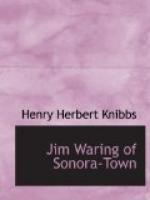“The rose is red; the violet blue;
Please shut this gate when you come through.”
And on the other side of the sign, challenging the possible carelessness of the chance visitor, was the legend:—
“Now you’ve been in and had
your chuck,
Please close this gate, just once, for
luck.”
Otherwise the place was like any mountain homestead of the better sort, viewed from without. The interior of the cabin, however, was unusual in that it boasted of being the only music-room within fifty miles in any direction.
When the genial Bud had been overtaken with the idea of homesteading, he had had visions of a modest success which would allow him to entertain his erstwhile cow-puncher companions when they should ride his way. To this end he had labored with more heart than judgment.
The main room was large and lighted by two unusually large windows. The dimensions of the room were ample enough to accommodate a fair number of dancers. Bud knew that if cowboys loved anything they loved to dance. The phonograph was so common that it offered no distinction in gracing Bud’s camp; so with much labor and expense he had freighted an upright piano from the distant railroad, an innovation that at first had stunned and then literally taken the natives off their feet. Riders from all over the country heard of Bud’s piano, questioned its reality, and finally made it a point to jog over and see for themselves.
For a time Bud’s homestead was popular. A real piano, fifty miles from a settlement, was something worth riding far to see. But respect for the shining veneer of the case was not long-lived. In a moment of inspiration, a cowboy pulled out his jackknife and carved his home brand on the shining case. Bud could have said more than he did when he discovered it. Later another contingent, not to be outdone, followed this cowboy’s incisive example and carved its brand on the piano. Naturally it became a custom. No visitor in boots and chaps left the cabin without first having carved some brand.
Bud suffered in silence, consoling himself with the thought that while there were many pianos in the lower country, there were none like his. And “As long as you don’t monkey with her works or shoot her up,” he told his friends, “I don’t care how much you carve her; only leave enough sidin’ and roof to hold her together.”
Cowboys came, danced long and late as Bud pumped the mechanical player, and thrilled to the shuffle of high-heeled boots. Contingent after contingent came, danced, and departed joyously, leaving Bud short on rations, but happy that he could entertain so royally. Finally the novelty wore off, and Bud was left with his Airedale, his saddle-ponies, and the hand-carved piano.




